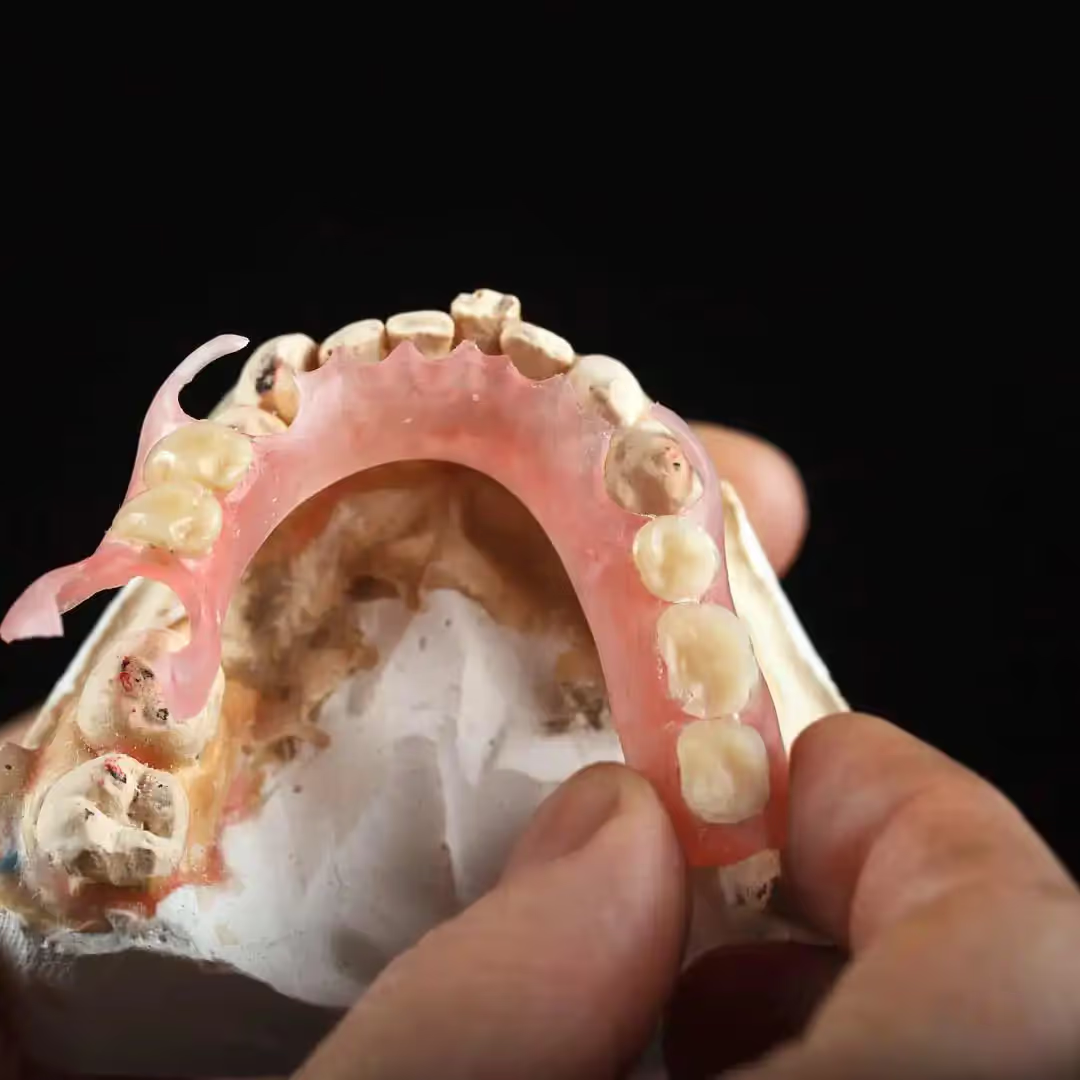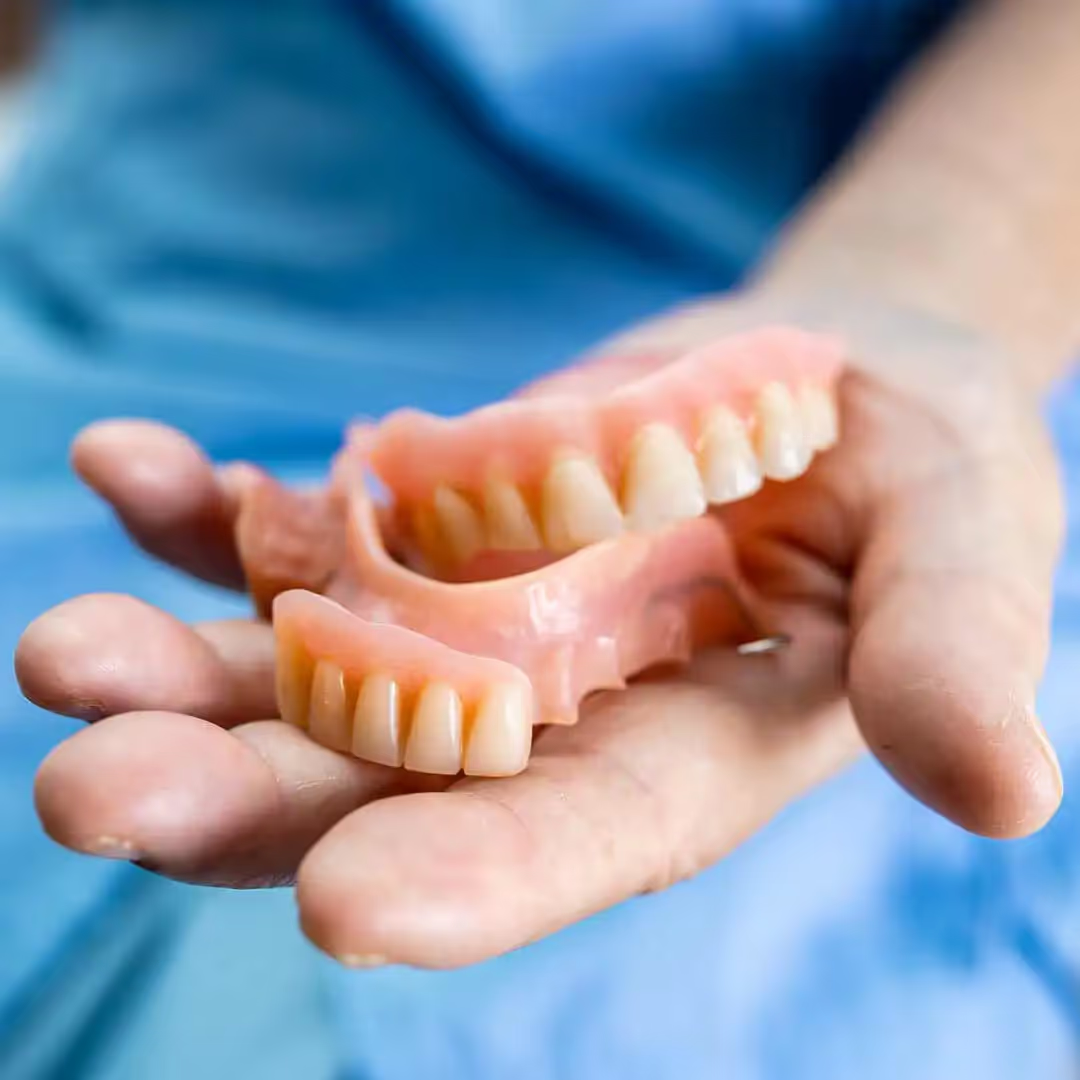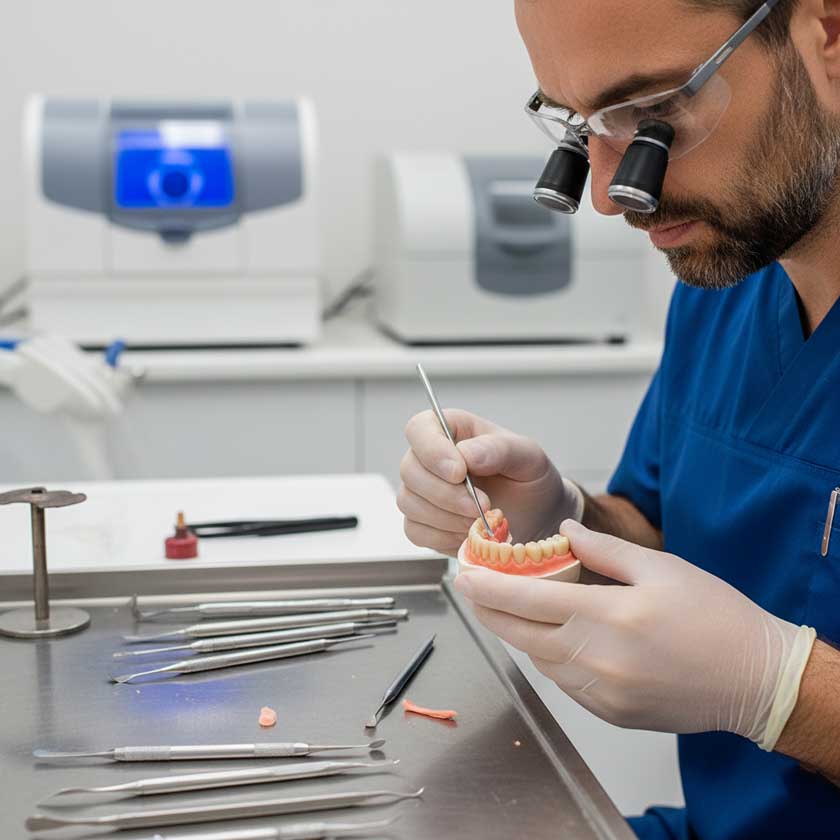Key takeaways
- Partial Dentures Overview: Custom-made to replace a few missing teeth, providing both functional and aesthetic benefits.
- Types of Partial Dentures: Options include cobalt chrome (durable, lightweight), acrylic (affordable, easily repairable), and flexible thermoplastic (easy to use, virtually unbreakable).
- Some higher-priced partial dentures incorporate advanced technology to achieve a more natural appearance and better fit.
- Alternative Options: Consider dental appliances such as dental implants (permanent, highly stable) and dental bridges (fixed, effective gap-filling) as more permanent solutions for missing teeth, especially for front teeth replacement.
- Choosing the Right Partial Denture: Factors include cost, procedure duration, appearance, functionality, maintenance, and longevity.
- Preserving Natural Teeth: Retaining natural teeth enhances denture stability, maintains jawbone integrity, and ensures a more natural-looking smile.
- Consequences of Not Replacing Missing Teeth: Leads to tooth shifting, gum disease, speech and eating difficulties, and lower self-esteem, making replacement crucial for oral health.

Understanding partial dentures.
What are partial dentures?
Partial dentures are custom-made appliances that replace a few missing teeth, restoring your smile and confidence. They can replace lost teeth, including front ones, but a dentist must check your teeth and oral health before fixing partials. You must have most of your natural teeth and be in good condition, with healthy gums, to get partial dentures.
Partial dentures consist of replacement teeth attached to a pink or gum-colored plastic base, sometimes supported by a metal framework to hold the denture in place. They are a great option for those who have lost a few teeth due to injury, decay, or other dental issues, offering aesthetic and functional benefits.
Partial dentures are especially advantageous for front teeth and are essential for appearance and everyday activities like eating and speaking. Filling the gaps left by missing teeth helps maintain the alignment of your remaining teeth and prevents them from shifting.
Moreover, partial dentures are typically removable, allowing easy cleaning and maintenance. Getting partial dentures usually involves a few dental visits, during which impressions of your mouth are taken, and the dentures are custom-made to fit comfortably and securely.
Partial dentures can help you enjoy a renewed sense of self-esteem and improved oral health. Properly fitted dentures ensure you can smile confidently and engage in daily activities without discomfort or embarrassment.
How do partial dentures work for missing teeth?
Partial dentures fill gaps left by missing teeth and can be either removable or fixed. They are typically made of plastic/acrylic and metal, customized to match the color and shape of your natural teeth, ensuring a natural look.
Removable partial dentures feature replacement teeth attached to a gum-colored plastic base, often supported by a metal framework. Some partial dentures use metal clasps to securely attach to natural teeth, providing a stable fit. They can be removed for cleaning and sleeping. Fixed partial dentures, or dental bridges, are anchored to existing teeth or implants, providing a more stable, permanent solution.
To create partial dentures, your dentist will take precise measurements and impressions of your mouth. This ensures a comfortable fit and a natural look. The dentures distribute chewing forces across your teeth and gums, reducing stress on individual teeth and maintaining proper alignment. A lower partial denture may require special attention to fit and retention due to the unique challenges of the lower jaw.
Partial dentures restore function and aesthetics, allowing you to eat, speak, and smile confidently. Whether removable or fixed, they provide a natural-looking and comfortable solution to improve oral health and quality of life.

Consequences of not replacing missing front teeth.
Effects of missing teeth on oral health and appearance.
Leaving gaps in teeth untreated can lead to problems such as tooth shifting, gum disease, and further tooth loss. When a front tooth is missing, the surrounding teeth may shift into the gap, causing misalignment and bite issues. This shifting can create spaces where food particles can get trapped, increasing the risk of gum disease and decay.
Missing front teeth can significantly affect one's speech and eating habits. One may need help pronouncing certain words or chewing food properly, which can impact one's overall nutrition and confidence in social situations.
Moreover, the absence of front teeth can alter your appearance and smile, affecting your self-esteem. A gap in your smile can make you self-conscious and may lead to a reluctance to engage in social interactions.
Consulting a dentist is crucial to discuss treatment options for replacing missing teeth. A professional can help you choose the best solution, such as partial dentures, to restore your smile and prevent further oral health issues.

Types of partial dentures for front teeth.
Cobalt chrome partial denture
Pros:
- Light
- Durable
- Low profile in the mouth
- Good longevity
Cons:
- More expensive than acrylic
- Only suitable for those with healthy natural teeth
Cobalt chrome partial dentures are a great option if you want something lightweight and durable. These dentures are known for their low profile and long-lasting performance. However, they come at a higher cost and are best for individuals with healthy remaining teeth.
Acrylic partial denture
Pros:
- Durable
- Most affordable
- Easily added to and repaired
Cons:
- Slightly thicker profile in the mouth
- Not as easy to use as flexible partial dentures
Acrylic partial dentures are the most budget-friendly option. They are durable and can be easily modified or repaired. The downside is that they have a thicker profile, which might feel bulkier in the mouth than other types.
Flexible thermoplastic partial denture
Pros:
- Easy to insert and remove
- Virtually unbreakable
Cons:
- Only suitable for replacing one to six teeth
- It is not clinically ideal for everyone
Flexible thermoplastic partial dentures are perfect for those seeking comfort and ease of use. These dentures are simple to insert and remove, and their flexibility makes them almost unbreakable. However, they're limited to replacing only a few teeth and may not be suitable for everyone.
Each type of partial denture offers unique benefits and potential drawbacks, so it's essential to consult with your dentist to determine which option best fits your needs and oral health condition.
Alternative options for replacing missing front teeth.
Dental implants: A permanent solution.
Dental implants are a titanium post anchored into the jawbone. They are sturdier than traditional bridges or dentures, offering a permanent and highly stable solution for missing teeth. Implants have three major components: the implant itself, which is the titanium post; the abutment, which connects the implant to the crown; and the crown, which is the visible part that looks like a natural tooth. This option provides excellent durability and a natural appearance, making it a preferred choice for many.
Dental bridges: A fixed option.
Dental bridges are a common and popular choice for replacing missing teeth. They consist of two or more crowns attached to adjacent natural teeth or implants. Bridges can permanently fill gaps caused by missing front and back teeth, restoring both function and aesthetics. This fixed solution is reliable and can be customized to match the color and shape of your natural teeth, providing a seamless look.
Consulting with a dentist or denture professional will help you determine the best option for your specific needs, whether you choose the permanence of implants or the fixed reliability of bridges.
The Process of Getting a Partial Denture
Getting a partial denture to replace missing teeth is a carefully planned process designed to restore your oral health and give you a complete, natural-looking smile. This journey involves several key steps, each aimed at ensuring your partial denture fits comfortably, functions well, and blends seamlessly with your remaining natural teeth.
Initial consultation and assessment
Your path to a new partial denture begins with an initial consultation with your dentist. During this visit, the dentist will thoroughly examine your mouth, checking the health of your remaining natural teeth, gums, and oral tissues. This assessment helps determine if partial dentures are the best solution for replacing your missing teeth. The dentist will also discuss the different types of partial dentures available, such as acrylic partial dentures, those with a metal framework, or flexible options, and help you choose the one that best suits your needs and lifestyle.
If any oral health issues are detected—like gum disease or problems with your existing teeth—these will need to be addressed before moving forward. Treating these concerns first ensures a healthy foundation for your new partial denture and helps prevent future complications.
Impressions and measurements
Once your oral health is in good shape and you’ve decided on the type of partial denture, the next step is to take precise impressions and measurements of your mouth. Using a special tray and a soft, gel-like material, your dentist will create detailed molds of your upper and lower teeth, gums, and the spaces where teeth are missing. These impressions capture the unique contours of your mouth, ensuring that your partial denture will fit comfortably and function properly.
Accurate measurements are also taken to make sure the partial denture aligns perfectly with your bite and the surrounding natural teeth. This careful attention to detail helps create a custom-made appliance that feels natural and supports your oral health.
Trial fitting and adjustments
After your partial denture has been crafted based on your impressions, you’ll return to the dentist for a trial fitting. During this appointment, the dentist will place the partial denture in your mouth and check for comfort, fit, and appearance. It’s common to need a few adjustments at this stage to ensure the partial denture doesn’t cause irritation and fits securely alongside your natural teeth.
You may need to visit your dentist more than once for these necessary adjustments. It’s important to handle your partial denture with care during this period—using a folded towel when cleaning it can help prevent accidental drops. Regular cleaning with a denture cleaning solution is essential to remove food particles and reduce the risk of gum disease, keeping both your partial denture and gums healthy.
Final placement
Once your partial denture fits comfortably and all adjustments have been made, it’s time for the final placement. Your dentist will check the fit one last time and make any final tweaks to ensure everything feels right. With your new partial denture in place, you’ll be able to enjoy a complete smile and improved oral health.
To keep your partial denture and surrounding natural teeth in top condition, daily cleaning and proper care are essential. Regular dental check-ups will help monitor your oral health and the fit of your partial denture, allowing for timely maintenance if needed. With the right care, your partial denture can provide a natural-looking, functional solution for replacing missing teeth, helping you smile, eat, and speak with confidence for years to come.
Choosing the right partial denture for front teeth.
Factors to consider.
Cost
Most people consider the cost of a partial front denture an important factor. It's crucial to consider the value for money and get more than one quote to ensure you get the best deal. Different materials and types of dentures come with varying price tags, so weigh your options carefully.
Pain and procedure
Pain is a subjective experience, and all partial front tooth replacement options can involve some degree of discomfort. The procedure for getting a removable partial denture typically takes between 3 to 6 weeks. It's important to discuss any concerns with your dentist to manage pain effectively during the process.
Appearance
Everyone wants a natural-looking result that is at least as good as, if not better than, their original teeth. Fortunately, all removable partial dentures are designed to provide a natural-looking appearance. Your dentist will match the color and shape of the dentures to blend seamlessly with your natural teeth.
Functionality
Functionality refers to the performance, stability, natural feel, and ease of care of your chosen teeth replacement. Removable partial dentures rely on surrounding natural teeth for support. They should fit comfortably, allowing you to eat, speak, and smile confidently.
Maintenance
Removable partial dentures need consistent care. Brush them twice a day and remove them at night for soaking, giving your oral tissues and gums a chance to rest. Periodic adjustments and relining are essential to adapt to changes in your bite and gum shrinkage over time.
Longevity
Chrome cobalt (or metal) partial dentures can last up to 20 years, whereas acrylic partial dentures usually last about 5-7 years. Over time, relines and adjustments may be necessary to keep them fitting snugly and ensure ongoing comfort and functionality.
Choosing the fitting partial denture for your front teeth involves considering these factors and consulting with your dentist to determine the best option for your needs and circumstances.
Preserving natural teeth with partial dentures.
Retaining as many natural teeth as possible.
Where possible, a partial denture is always a preferable option to a full denture. Preserving natural teeth provides stability and comfort for your denture. Natural teeth are anchors, making the partial denture more secure and functional.
Keeping your natural teeth also helps maintain the integrity of your jawbone and facial structure, preventing the bone loss that often accompanies missing teeth. This preservation contributes to a more comfortable fit and a better overall dental health outcome.
Partial dentures can help restore a natural-looking smile, blending seamlessly with your remaining teeth. Filling in the gaps prevents the shifting of natural teeth and improves your ability to eat and speak properly.
Opting for partial dentures enhances the aesthetic appeal of your smile and supports your long-term oral health. Retaining as many natural teeth as possible ensures a more stable, comfortable, and effective denture solution.








